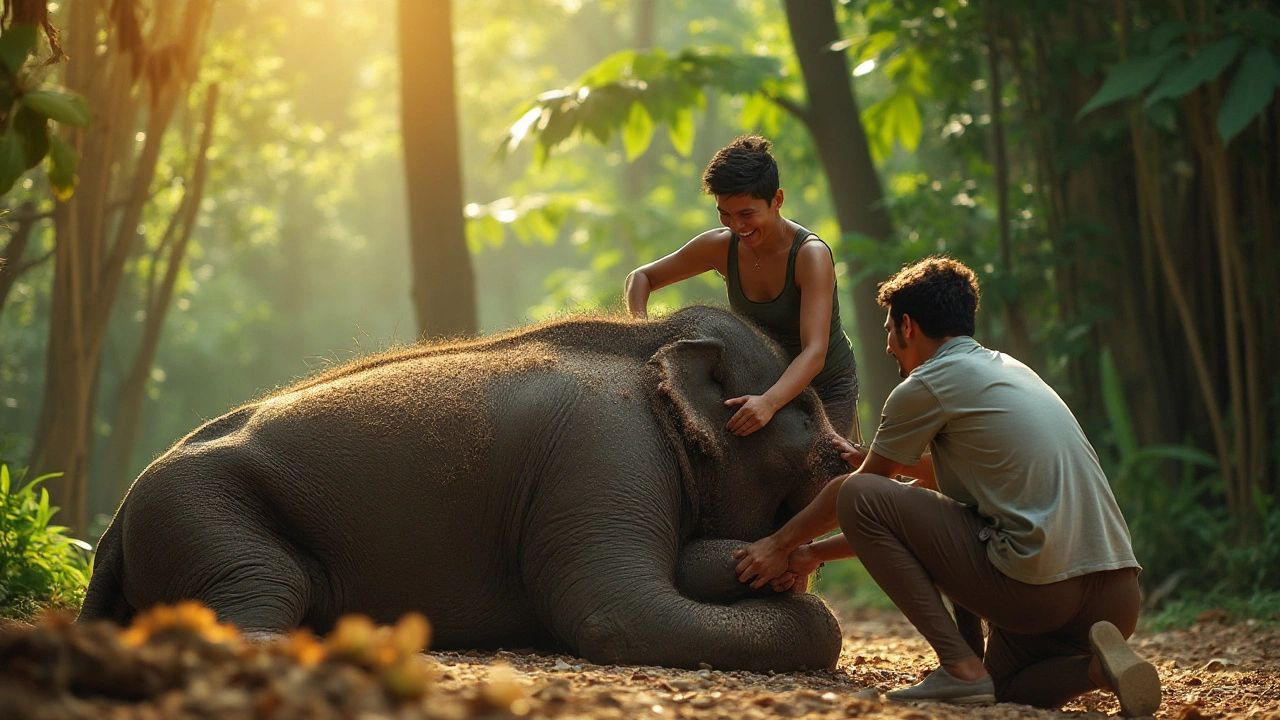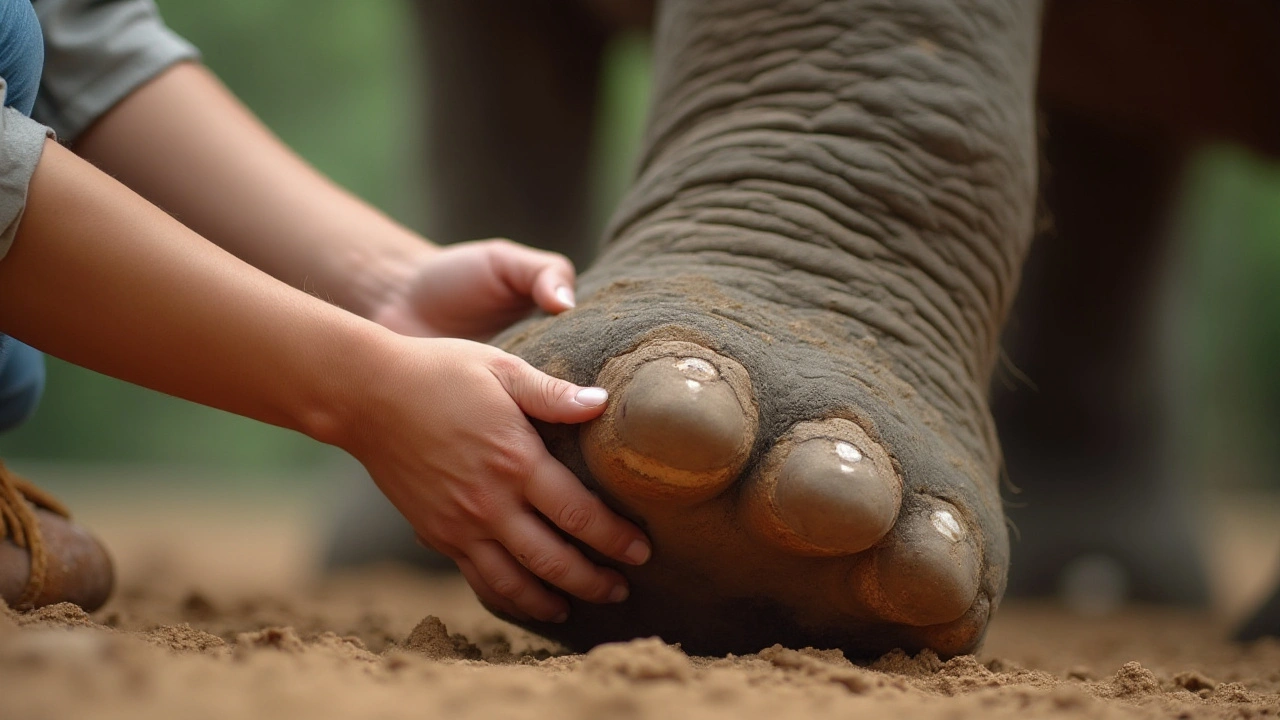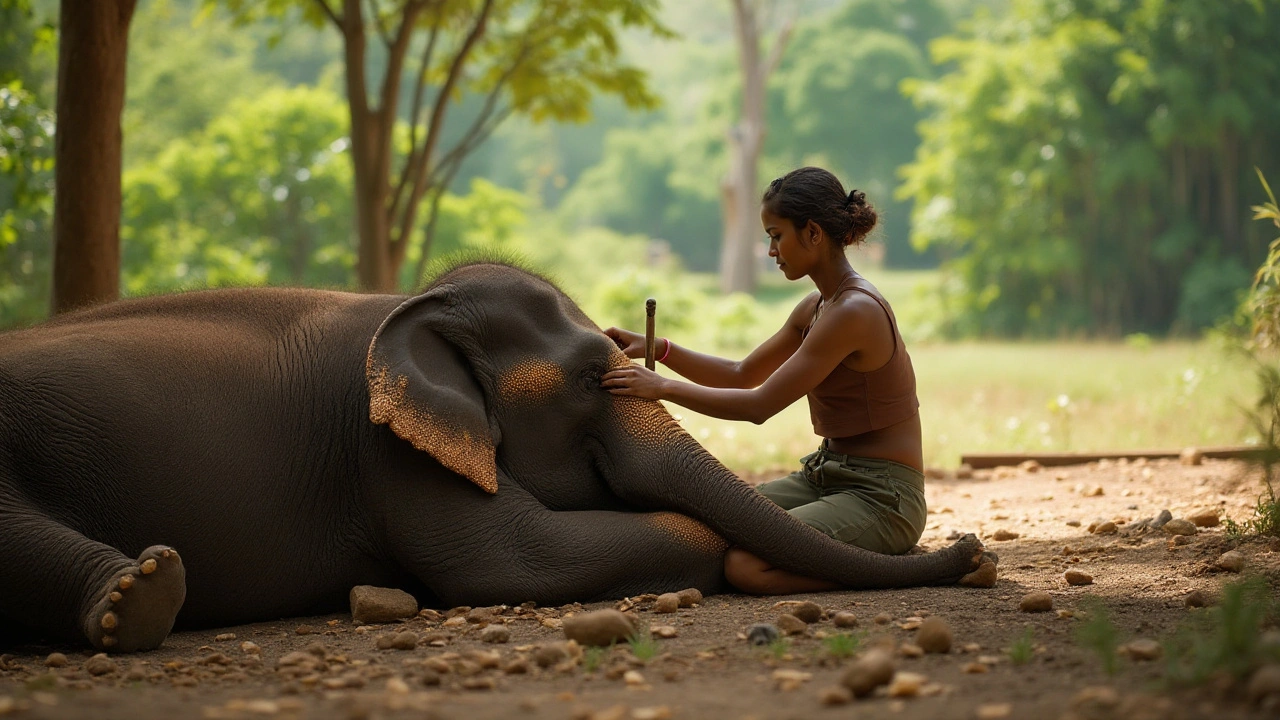Exploring the Wonders of Elephant Massage: Art and Science Unveiled

Imagine an elephant receiving a massage in the midst of a serene jungle setting. While it might seem like a scene from a fantasy, elephant massage is a real and thriving practice in certain parts of the world. It's a unique blend of tradition, care, and modern science, aimed at enhancing the well-being of these magnificent animals.
This practice has ancient roots, yet continues to evolve as people find new ways to keep elephants happy and healthy. Handlers have developed techniques that cater to the specific needs of elephants, aiding in muscle relaxation, stress relief, and overall health. This not only benefits the elephants but also strengthens the bond between them and their caregivers. Unraveling the techniques and science behind elephant massage can deepen our understanding of animal care and highlight the importance of preserving these gentle giants.
- Introduction to Elephant Massage
- Historical Background
- Scientific Benefits
- Techniques and Tools
- Human-Elephant Connection
- Impact on Conservation
Introduction to Elephant Massage
Elephant massage is not just a charming spectacle to behold; it is an intricate practice steeped in ancient tradition. This unique form of therapy can be traced back to the cultural landscapes of Asia, particularly Thailand, where the profound relationship between humans and elephants has been nurtured for centuries. The concept of massage isn't new to Asia, where it is considered a valued healing art, applied to humans and, surprisingly, to elephants.
These gentle giants spend their days engaged in heavy labor or entertaining crowds, both of which can take a toll on their mighty bodies. This is where elephant massage plays a pivotal role. Handlers, known locally as mahouts, have for generations developed skills to soothe and relax these animals. By applying pressure to specific muscle groups, they relieve tension, increase circulation, and promote a sense of well-being in the elephants. The techniques are adapted from traditional massage methods that humans benefit from but are carefully adjusted for the elephant's size and physiology.
Unlike massages for humans, an elephant massage session is a team effort. A group of mahouts can work in harmony to cover the vast expanse of an elephant's body. They may tap into a repertoire of techniques that include rhythmic tapping, kneading, and stretching. This coordinated effort not only aids in physical relief but fosters an emotional bond of trust and mutual affection. Elephants, known for their keen intelligence and sensitivity, respond to touch in a manner that reflects their well-documented emotional depth.
The Science of Relaxation
The impact of massage on animals, including elephants, has caught the eye of scientists, offering a remarkable insight into its benefits. When receiving massages, elephants showcase increased levels of endorphins and a marked reduction in stress hormones. This echoes similar findings in human studies where massage aids in decreasing cortisol levels and heightening the hormones that promote happiness.
"Elephants, like humans, benefit tremendously from tactile sensations that reaffirm their social bonds and provide physical comfort," states Dr. Emily Andrews, an acclaimed ethologist, who has studied the intricate lives of elephants for over two decades.Research sheds light on how crucial these practices are in enhancing their quality of life, especially in captivity. These findings are compelling for conservationists and animal care professionals seeking methods to elevate the welfare standards for elephants globally.
| Benefit | Impact |
|---|---|
| Increased Circulation | Enhances oxygen flow to muscles, relieving pain |
| Relaxation | Promotes calm and reduces stress behaviors |
| Improved Socialization | Encourages trust-building between elephants and handlers |
Ultimately, introducing elephant massage as a central part of their care regime addresses both physical ailments and the psychological well-being of these magnificent creatures. It highlights an engaging approach to caring for wildlife while reflecting a deep-rooted commitment to preserving their welfare. The practice bridges cultural traditions with modern animal care philosophies, creating a harmonious blend of ritual and innovation.
Historical Background
The practice of elephant massage may seem like a modern trend, but its origins trail back centuries, rooted deeply in the cultures of Southeast Asia. Traditionally, elephants have been revered not only as symbolic animals of immense power and wisdom but also as vital companions in daily life. From pulling logging trees in dense forests to being central figures in religious and cultural ceremonies, elephants have long been an integral part of human history in this region. Hence, ensuring their health and well-being became paramount, leading to the development of massage techniques tailored specifically for these magnificent beasts.
Throughout ancient Thailand, mahouts—traditional elephant caretakers—practiced various methods to care for their elephants. They understood that regular physical attention was needed to keep the elephants healthy for the demanding tasks they had to perform. This practice blended regional knowledge of herbal medicine and the natural healing topographies available in their surroundings. Often, tribal communities shared their wisdom, crafting a legacy that has transcended generations. The elephants themselves responded to these routines, forming emotional bonds with their handlers that were equally therapeutic for both parties.
The idea of energetically balancing the body is an old concept present in many traditional Asian medical systems, and this was adapted for elephants by those early practitioners. They paid close attention to the animals’ physical and emotional cues, developing a nuanced understanding of their needs. These methods did not involve only physical touch but also incorporated sounds and rhythmic movements. Over time, these locally derived traditions drew the interest of both international animal behaviorists and veterinarians. The latter began to see the inherent value in integrating these old customs with modern scientific perspectives.
According to a study by Thai Elephant Conservation Center, "Traditional elephant massage methods have proven highly effective in reducing stress and improving the quality of life for elephants, particularly those in captivity."
In places like Kerala in India, where elephants also have a high cultural significance, similar practices were developed. The festival elephants, adorned and showcased in grand processions, were attended to with great care, ensuring that their journey was one of comfort and wellness, thanks to the attention they received from skilled mahouts and Ayurvedic practitioners. Each culture wove its tapestry of practices, but the common thread was always the elephant's health and happiness. As these traditional methods garnered acclaim, they were studied more thoroughly, and their techniques began to be documented. This blossomed into a more structured routine in the world of veterinary science.
It's fascinating to observe how the modern practice of elephant massage has emerged from these ancient traditions. The wisdom of mahouts echoes through time, still employed with some advancements today. The allure of these practices captures the attention not only for its mystique but also for its tangible benefits, paving the way for an intersection of ancient wisdom and contemporary wellness approaches.

Scientific Benefits
Delving into the scientific benefits of elephant massage reveals a fascinating intersection of biology, behavior, and well-being. Elephants, much like humans, exhibit signs of physical strain and stress that can affect their health and longevity. Regular massages provide tangible benefits, addressing these issues with tried-and-true techniques that are surprisingly effective. Veterinary experts have noted that consistent massage therapy can lead to improved circulation, which is crucial in such large animals, as it aids in distributing essential nutrients and oxygen throughout their massive bodies. This enhanced circulation contributes to the elimination of waste products, boosting the elephants' immune system efficiency and overall health.
Another compelling advantage of elephant massage is its impact on stress levels. These powerful yet gentle creatures often face significant stress, whether from captivity, environmental changes, or social dynamics within their herds. Massage helps release tension stored within their muscles, creating a calm and relaxed state that fosters better social interactions and reduces incidences of aggression. Studies also suggest that regular massage can help alleviate symptoms of arthritis and joint pain, common afflictions in older elephants, by improving flexibility and range of motion. This treatment provides not only physical relief but also promotes mental relaxation, essential for the complex psychological well-being of elephants.
"Massage therapy in elephants can effectively decrease stress and promote behavioral stability, enhancing their overall quality of life," said Dr. Jane Goodall, renowned primatologist and advocate for wildlife conservation.
Interestingly, understanding how elephant massage works has opened doors to further research in animal therapy. By observing the elephants' responses to different techniques, researchers gain insights into the dynamics of animal mind-body connections. Social bonding is another significant benefit, as elephants establish stronger relationships with their caregivers through the trust and affection that short yet regular massage sessions foster. This interaction has been shown to enhance cooperation during medical treatments and stimulate positive behavior changes. Such improvements, although seemingly small, can play a major role in the daily care and management of these majestic animals, lending support to their conservation in captivity and the wild.
Research and Future Possibilities
Ongoing research seeks to validate many of these observed benefits with concrete data, promising to enhance the standards of animal welfare practices worldwide. As new technologies and methodologies become available, understanding the biochemical processes underlying the responses to massage therapy will refashion how experts approach not only elephant care but also therapy for other large mammals. This promises to conserve the well-being of elephants while also advocating for eco-friendly, sustainable, and ethical methods in animal tourism.
Elephant care evolves as a field, drawing more interest from the scientific community, conservationists, and the ethically-conscious public. These efforts collectively ensure a future where elephants can thrive alongside humans, gracefully benefiting from interactions that respect their intrinsic needs and untamed spirit.
Techniques and Tools
Elephant massage might seem like an exotic luxury, but it’s very practical for maintaining the health of these large animals. Just as humans benefit from massage, elephants do too, helping with blood circulation, easing tense muscles, and sometimes even enhancing mood. The massage routine for elephants is meticulously planned by experienced handlers who have a deep understanding of the animals’ needs. Each technique is adapted considering the huge size and unique anatomy of elephants. Understanding which part of an elephant's massive body requires attention comes from years of close observation and interaction with the animal, ensuring that each session results in the best possible outcome for the animal’s wellbeing.
One of the core techniques used in elephant massage is the ‘deep pressure’ method. Unlike humans who might feel overwhelmed by such force, elephants appreciate firm pressure due to their thick skin and dense muscles. This involves using large, smooth stones or specially crafted wooden objects, often heated, to work the kinks out of muscles that could otherwise lead to discomfort. With elephants thriving on regular movement, keeping their muscles pliable is crucial. Massage sessions often start from the trunk, where elephants can store a lot of tension, moving gradually to their legs and finally to their broad backs. If handled with care, these massages can help in keeping the elephants active and happy.
Another fascinating tool often employed is aromatherapy. Essential oils like lavender or peppermint are occasionally used, not directly on the skin, but in diffusers around the massage area. This helps in creating a calming atmosphere, enhancing relaxation for the elephants. You'd wonder, do elephants really enjoy such luxuries? In truth, elephants are highly sensory animals, and gentle scents can significantly aid in reducing stress or anxiety, especially in rescued or rehabilitated ones. This holistic approach integrates both physical and mental health, creating a more harmonious environment.
"For the elephants, being touched and massaged strengthens their trust in humans, which can be crucial in their rehabilitation and care," says Dr. Natalie Seymour, a wildlife vet renowned for her work on elephant welfare and rehabilitation.
A noteworthy fact is the involvement of play, which is an unconventional part of the massage process. Often, the sessions include small segments where elephants engage with water, mud, or dust. Known as 'dust baths', these are not only a fun and natural form of exfoliation but also a necessary part of their skin care routine, helping protect against insects and sunburn. In terms of tools, these are more natural – the earth itself is used to massage the animals, as an extension of the traditional techniques. This approach exemplifies the seamless blend of nature and nurture in wildlife care.
Adapting Techniques for Individual Needs
One key aspect of elephant massage is its adaptability. Each elephant has its own temperament, preferences, and physical needs, which means that handlers have to be quite intuitive and responsive. They adjust weather conditions, the type of oils if used, and even the intensity of the massage. Proper training is crucial for handlers to not only perform these techniques but also understand when an elephant is comfortable or when it might be signaling distress. A detailed knowledge of elephant psychology helps in making this therapy effective, ensuring that each creature feels nurtured and respected during the process.
Finally, massage sessions are part of larger conservation efforts, indirectly aiding in building a sustainable connection between humans and these magnificent giants. As elephants bond with their caretakers through these interactions, the mutual respect cultivated becomes instrumental for both parties, benefiting conservation and rehabilitative efforts enormously.

Human-Elephant Connection
In many cultures, elephants hold a sacred position, often symbolizing wisdom, strength, and good fortune. The human-elephant connection dates back thousands of years, woven into the folklore, religions, and daily life of various societies. This bond has manifested in numerous ways, from elephants aiding in agricultural labor to their role in religious and cultural festivals. But beyond the practical and symbolic, the relationship between humans and elephants is deeply personal. Caretakers, or mahouts, often form profound bonds with elephants, seeing them as family rather than mere animals to be managed. This intricate relationship is at the heart of elephant massage practices, where the mutual trust between elephant and handler is crucial for effective therapy.
Elephants, with their complex social structures and emotional depth, are known to exhibit behaviors akin to human emotions. They've been observed forming friendships, grieving losses, and even displaying empathy. This emotional intelligence means that they can respond positively to affection and care, which further strengthens their bond with humans. The art of elephant massage is not just about the physical act itself, but about the conversations—albeit non-verbal—that happen between the elephant and its handler during the process. Such massages can become a time of relaxation and communication, allowing both parties to connect on a level that's beyond words.
Research has shown that elephants have a high level of self-awareness, similar to dolphins and primates. This ability to understand their environment and interactions makes them keen participants in their care routines. The massage sessions can provide relief from stress and physical discomfort, while also fostering trust and cooperation. Many elephant handlers report that massaging their elephants leads to noticeable behavioral changes—elephants may appear more relaxed and content. Animal therapy practitioners note that the bond developed through such interactions can significantly enhance the well-being of these majestic creatures.
The Emotional Echoes
By participating in massage, elephants are expressing their trust and readiness to interact with humans in a peaceful setting. This exchange highlights the deep-seated respect and empathy human caregivers feel for their charges. Moreover, the tangible benefits of such interactions often find their way back to conservation efforts. Empowered by these connections, those working with elephants are more invigorated to advocate for protections that ensure the survival of these intelligent giants. It's also a shining example of how ethical elephant care practices can forge a uniquely symbiotic relationship between humans and animals."The more we understand elephants, the more we see the importance of empathy and compassion," says renowned conservationist Jane Goodall. "Our task is to respect and learn from these great animals, to care for them as our own."
Many elephants in captivity today owe their survival to such intimate connections. At elephant sanctuaries worldwide, massage therapy becomes a channel for positive human interaction. It’s heartening to see people and elephants working together, crafting a shared future. The ancient tradition of elephant massage offers us a glimpse into this world—a harmonious blend of art, science, and shared emotion that speaks to the heart of the human-elephant connection.
Impact on Conservation
Elephant massage practices are deeply intertwined with conservation efforts, providing a significant impact that extends beyond the borders of wildlife sanctuaries. By promoting the welfare of elephants through therapeutic methods, a strong message about the importance of maintaining healthy wildlife populations is spread. This, in turn, educates the public and fosters a culture of conservation. Improved care and attention mean elephants live longer, healthier lives, which is crucial for a species whose numbers have been dwindling. Ensuring the survival and well-being of these magnificent creatures can reverse their declining population trend. The ethical care of elephants is about more than just keeping them alive; it's about enriching their lives and the ecosystems they inhabit.
Nurturing elephants through massage demonstrates a profound respect for their role in the natural world. In many regions, elephant populations are integral to the environment, playing a key role in maintaining the ecological balance. They are known as "ecosystem engineers" because of their ability to modify their habitat. Their activities, such as grazing and trampling, create open areas in dense woodlands allowing other species to thrive. By supporting efforts like elephant massage, we are indirectly contributing to ecological preservation and biodiversity. Also, this practice incentivizes conservation by linking the wellness of elephants to tourism and local economies. Attracting tourists with a keen interest in conservation and wellness can provide essential funds for wildlife sanctuaries and protection programs.
Studies suggest that well-cared-for elephants are healthier, less aggressive, and happier, which reduces the risk of conflict with humans. This is vital as human-elephant conflicts pose a severe threat to their survival. Initiatives that emphasize cooperation and mutual benefit between humans and elephants help alleviate these tensions. Implementing massage as part of routine care serves as an innovative approach to reducing such conflicts. When elephants are perceived as valuable and integral to a community, their chances of survival are significantly enhanced. Through these loving interactions, local communities are encouraged to see elephants as a treasure rather than a nuisance.
An inspiring quote from Dr. Jane Goodall sums up the transformational potential of these conservation efforts:
"What you do makes a difference, and you have to decide what kind of difference you want to make."As we look to the future, integrating unique wellness practices like elephant massage into conservation strategies reflects an evolving understanding of holistic animal care. It underlines a commitment to a compassionate ethic that sees animals not as resources to be managed but as sentient beings deserving of respect and affection.
To further amplify the conservation impact, collaborations between wildlife sanctuaries, researchers, and wellness practitioners can foster innovations that enhance the effectiveness of such initiatives. Workshops and educational programs can involve local communities in conservation practices, creating more awareness and active participation. Additionally, research into the physiological benefits of massage can provide critical insights, reinforcing the importance of these efforts. By standing at the convergence of care, conservation, and science, elephant massage plays a role in shaping a sustainable future for these extraordinary animals.





